Posted on May 30th, 2017 by Mary Lord
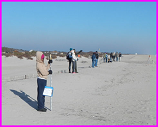 High school students working in groups of three to four learn about the primary causes and impacts of coastal erosion, and use elevation data to construct profiles of a beach over time or to compare several beaches, make inferences about the erosion process, and discuss how humans should respond.
High school students working in groups of three to four learn about the primary causes and impacts of coastal erosion, and use elevation data to construct profiles of a beach over time or to compare several beaches, make inferences about the erosion process, and discuss how humans should respond.
Read More
Filed under: Class Activities, Grades 9-12, Grades 9-12, Grades 9-12, Lesson Plans | Comments Off on Who Moved the Beach?
Tags: beach, Civil Engineering, Class Activities, coastal erosion, coastal management, data analysis, Earth Science, Environmental Engineering, erosion, Grades 9-12, jetties, Lesson Plan, NOAA, USGS
Posted on December 12th, 2016 by Mary Lord
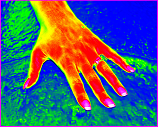 In this lesson, high school students learn the value of writing and art in science and engineering by designing visual diagrams to communicate the results of thermal conductivity (heat flow) experiments they have conducted to anyone with little background on the subject. The principles of visual design include contrast, alignment, repetition, and proximity, and involve such elements as the use of lines, color, texture, shape, size, value, and space.
In this lesson, high school students learn the value of writing and art in science and engineering by designing visual diagrams to communicate the results of thermal conductivity (heat flow) experiments they have conducted to anyone with little background on the subject. The principles of visual design include contrast, alignment, repetition, and proximity, and involve such elements as the use of lines, color, texture, shape, size, value, and space.
Read More
Filed under: Class Activities, Grades 9-12, Grades 9-12, Lesson Plans | Comments Off on Visualize STEM
Tags: Art, Class Activities, diagram, experiment, Grades 9-12, graphic design, heat flow, Presentations, STEAM, Technical Communications, thermal imaging, writing
Posted on December 24th, 2015 by Mary Lord
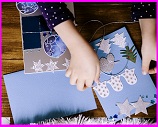 In this collaborative math and art lesson, students in grades 4 through high school explore central ideas in industrial engineering – including productivity, efficiency, and quality – by designing their own assembly line and working together to mass produce greeting cards.
In this collaborative math and art lesson, students in grades 4 through high school explore central ideas in industrial engineering – including productivity, efficiency, and quality – by designing their own assembly line and working together to mass produce greeting cards.
Read More
Filed under: Class Activities, Grades 6-8, Grades 6-8, Grades 9-12, Grades 9-12, Grades K-5, Grades K-5, Lesson Plans | Comments Off on Greeting Card Assembly Line
Tags: Art, assembly line, Class Activities, Common Core State Mathematics Standards, girls in STEM, Grades 6-8, Grades 9-12, Grades K-5, greeting card, Industrial engineering, Lesson Plans, Math, STEAM
Posted on July 10th, 2015 by Mary Lord
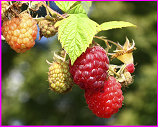 High school students working in teams of four learn how a device made with dye from berries can be used to convert light energy into electrical energy by building their own organic solar cells and measuring performance based on power output.
High school students working in teams of four learn how a device made with dye from berries can be used to convert light energy into electrical energy by building their own organic solar cells and measuring performance based on power output.
Read More
Filed under: Class Activities, Grades 9-12, Grades 9-12, Lesson Plans | Comments Off on Berry Organic Solar Energy
Tags: Alternative Energy, berry, Chemical Engineering, Class Activities, curcuits, electrical circuits, Electrical Engineering, electricity, Grades 9-12, materials, organic, Solar Energy, Sustainability
Posted on June 26th, 2015 by Mary Lord
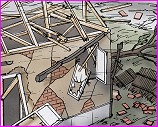 In this activity for middle school science, high school physics, or engineering, groups of students explore the housing crisis caused by natural disasters by applying appropriate technology and fluid mechanics to design sustainable shelters that can withstand flooding and high winds.
In this activity for middle school science, high school physics, or engineering, groups of students explore the housing crisis caused by natural disasters by applying appropriate technology and fluid mechanics to design sustainable shelters that can withstand flooding and high winds.
Read More
Filed under: Class Activities, Grades 6-8, Grades 6-8, Grades 9-12, Grades 9-12, K-12 Outreach Programs, Lesson Plans | Comments Off on Disaster-Proof Housing
Tags: Archimedes principle, Bernoulli, Class Activities, Design, disaster shelter, Engineering Design Process, fluid dynamics, Grades 6-8, load, Physics, statics
Posted on February 22nd, 2015 by Mary Lord
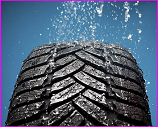 In this hands-on activity, teams of students in grades 3 to 12 learn how engineers design tire treads to increase safety and reliability, then follow the design process to construct, test, and evaluate treads sculpted from clay that will be safe when driving in heavy rain.
In this hands-on activity, teams of students in grades 3 to 12 learn how engineers design tire treads to increase safety and reliability, then follow the design process to construct, test, and evaluate treads sculpted from clay that will be safe when driving in heavy rain.
Read More
Filed under: Class Activities, Grades 6-8, Grades 6-8, Grades 9-12, Grades 9-12, Grades K-5, Grades K-5, Lesson Plans | Comments Off on How the Rubber Meets the Road
Tags: Automotive engineering, car, Class Activities, Engineering Design, Lesson Plan, safety, tire, Transportation, tread
Posted on December 30th, 2014 by Mary Lord
 In this activity, high school juniors and seniors learn such core chemistry concepts as reaction rates and thermodynamics by making and demonstrating their own Harry Potter-style “magic wands” (sparklers). The lab, which also can serve as a fun Advanced Placement course review, concludes with a class duel between wands of two different chemical compositions.
In this activity, high school juniors and seniors learn such core chemistry concepts as reaction rates and thermodynamics by making and demonstrating their own Harry Potter-style “magic wands” (sparklers). The lab, which also can serve as a fun Advanced Placement course review, concludes with a class duel between wands of two different chemical compositions.
Read More
Filed under: Class Activities, Grades 9-12, Grades 9-12, Lesson Plans | Comments Off on Wizardly Wands
Tags: Advanced Placement, Chemical Engineering, Chemistry, Class Activities, Energy, Grades 9-12, Harry Potter, Next Generation Science Standards, reaction rates, sparklers, STEM education, stochiometry, wand
Posted on December 11th, 2014 by Mary Lord
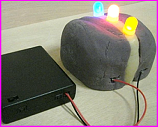 In this fun activity developed by St. Thomas University engineering associate professor AnnMarie Thomas, students of all ages learn the basic principles of electricity by fashioning circuits from play dough, batteries, and LEDs. No soldering necessary!
In this fun activity developed by St. Thomas University engineering associate professor AnnMarie Thomas, students of all ages learn the basic principles of electricity by fashioning circuits from play dough, batteries, and LEDs. No soldering necessary!
Read More
Filed under: Class Activities, Grades 6-8, Grades 6-8, Grades 9-12, Grades K-5, Grades K-5, Lesson Plans, Web Resources | 1 Comment »
Tags: afterschool activities, circuits, Class Activities, Electrical Engineering, electricity, Energy, Grades 6-8, Grades 9-12, Grades K-5, LEDs, lights, Squishy Circuits, St. Thomas University, STEM education
Posted on April 21st, 2014 by Mary Lord
 In this activity, students in grades 9-11 learn how engineers harness the energy of the wind by following the engineering design process to create and test two prototype wind turbines to see which works best. They also learn about where to place a wind turbine for maximum effectiveness, and to weigh the advantages and disadvantages compared with other energy sources.
In this activity, students in grades 9-11 learn how engineers harness the energy of the wind by following the engineering design process to create and test two prototype wind turbines to see which works best. They also learn about where to place a wind turbine for maximum effectiveness, and to weigh the advantages and disadvantages compared with other energy sources.
Read More
Filed under: Class Activities, Grades 9-12, Grades 9-12, Lesson Plans | Comments Off on Wind Power for Your Home
Tags: Alternative Energy, Civil Engineering, Class Activities, efficiency, Environmental Engineering, Environmental science, Grades 9-12, Green Technology, kinetic energy, Lesson Plan, Mechanical engineering, renewable energy, STEM education, Sustainability, turbine, wind power
 High school students working in groups of three to four learn about the primary causes and impacts of coastal erosion, and use elevation data to construct profiles of a beach over time or to compare several beaches, make inferences about the erosion process, and discuss how humans should respond.
High school students working in groups of three to four learn about the primary causes and impacts of coastal erosion, and use elevation data to construct profiles of a beach over time or to compare several beaches, make inferences about the erosion process, and discuss how humans should respond.








 In this lesson, high school students learn the value of writing and art in science and engineering by designing visual diagrams to communicate the results of thermal conductivity (heat flow) experiments they have conducted to anyone with little background on the subject. The principles of visual design include contrast, alignment, repetition, and proximity, and involve such elements as the use of lines, color, texture, shape, size, value, and space.
In this lesson, high school students learn the value of writing and art in science and engineering by designing visual diagrams to communicate the results of thermal conductivity (heat flow) experiments they have conducted to anyone with little background on the subject. The principles of visual design include contrast, alignment, repetition, and proximity, and involve such elements as the use of lines, color, texture, shape, size, value, and space. In this collaborative math and art lesson, students in grades 4 through high school explore central ideas in industrial engineering – including productivity, efficiency, and quality – by designing their own assembly line and working together to mass produce greeting cards.
In this collaborative math and art lesson, students in grades 4 through high school explore central ideas in industrial engineering – including productivity, efficiency, and quality – by designing their own assembly line and working together to mass produce greeting cards. High school students working in teams of four learn how a device made with dye from berries can be used to convert light energy into electrical energy by building their own organic solar cells and measuring performance based on power output.
High school students working in teams of four learn how a device made with dye from berries can be used to convert light energy into electrical energy by building their own organic solar cells and measuring performance based on power output. In this activity for middle school science, high school physics, or engineering, groups of students explore the housing crisis caused by natural disasters by applying appropriate technology and fluid mechanics to design sustainable shelters that can withstand flooding and high winds.
In this activity for middle school science, high school physics, or engineering, groups of students explore the housing crisis caused by natural disasters by applying appropriate technology and fluid mechanics to design sustainable shelters that can withstand flooding and high winds. In this hands-on activity, teams of students in grades 3 to 12 learn how engineers design tire treads to increase safety and reliability, then follow the design process to construct, test, and evaluate treads sculpted from clay that will be safe when driving in heavy rain.
In this hands-on activity, teams of students in grades 3 to 12 learn how engineers design tire treads to increase safety and reliability, then follow the design process to construct, test, and evaluate treads sculpted from clay that will be safe when driving in heavy rain. In this activity, high school juniors and seniors learn such core chemistry concepts as reaction rates and thermodynamics by making and demonstrating their own Harry Potter-style “magic wands” (sparklers). The lab, which also can serve as a fun Advanced Placement course review, concludes with a class duel between wands of two different chemical compositions.
In this activity, high school juniors and seniors learn such core chemistry concepts as reaction rates and thermodynamics by making and demonstrating their own Harry Potter-style “magic wands” (sparklers). The lab, which also can serve as a fun Advanced Placement course review, concludes with a class duel between wands of two different chemical compositions.  In this fun activity developed by St. Thomas University engineering associate professor AnnMarie Thomas, students of all ages learn the basic principles of electricity by fashioning circuits from play dough, batteries, and LEDs. No soldering necessary!
In this fun activity developed by St. Thomas University engineering associate professor AnnMarie Thomas, students of all ages learn the basic principles of electricity by fashioning circuits from play dough, batteries, and LEDs. No soldering necessary! In this activity, students in grades 9-11 learn how engineers harness the energy of the wind by following the engineering design process to create and test two prototype wind turbines to see which works best. They also learn about where to place a wind turbine for maximum effectiveness, and to weigh the advantages and disadvantages compared with other energy sources.
In this activity, students in grades 9-11 learn how engineers harness the energy of the wind by following the engineering design process to create and test two prototype wind turbines to see which works best. They also learn about where to place a wind turbine for maximum effectiveness, and to weigh the advantages and disadvantages compared with other energy sources.